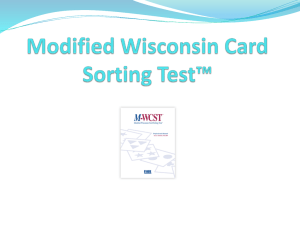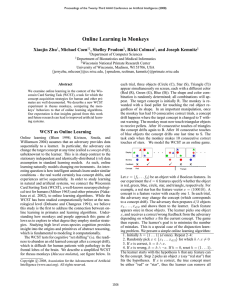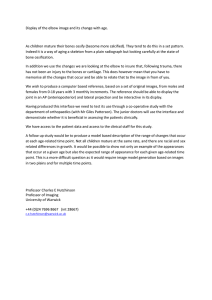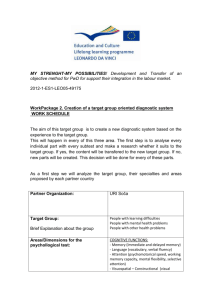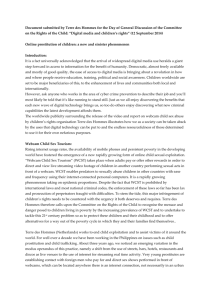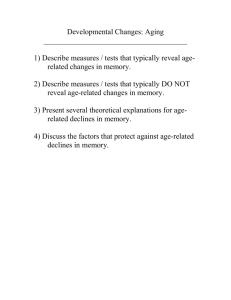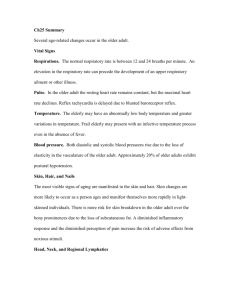Document 14070024
advertisement
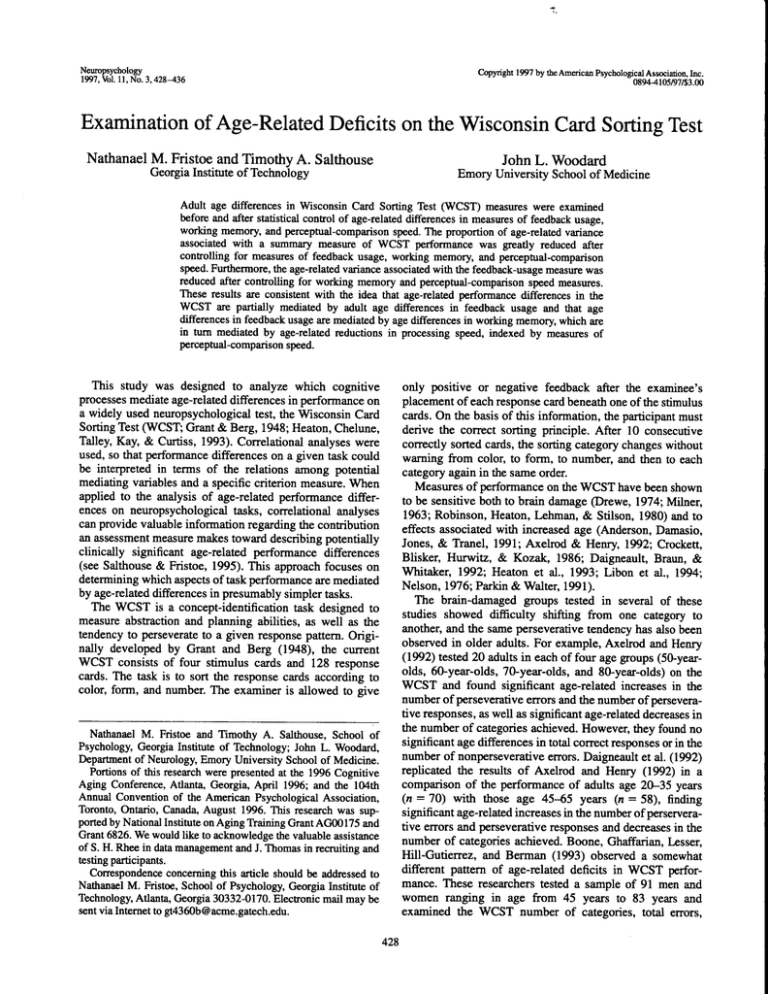
Neumpsychology
1997,\iol.11,No.3,428-436
C-opyright1997by theAmericanPsychologicalAssociation,Inc.
089214105D7/$3.00
Examinationof Age-Related
Deficitson theWisconsinCardSortingTest
NathanaelM. Fristoe and Timothy A. Salthouse
John L. Woodard
EmoryUniversitySchoolof Medicine
Georgia Institute of Technoiogy
Adult age differences in wisconsin card Sorting Test (wcST) measures were examined
before and after statistical confiol of age-related differences in measures of feedback usage,
working memory, and perceptual-comparison speed. The proportion of age-related variance
associated with a summary measure of wCST performance was greatly reduced after
controlling for measures of feedback usage, working memory and perceptual-comparison
speed.Furthermore, the age-related variance associated with the feedback-usage measure was
reduced after controlling for working memory and perceptual-comparison speed measures.
These results are consistent with the idea that age-related performance differences in the
WCST are partially mediated by adult age differences in feedback usage and that age
differences in feedback usage are mediated by age differences in working memory which are
in turn mediated by age-related reductions in processing speed, indexed by measures of
perceptual-comparison speed.
This study was designed to analyze which cognitive
processesmediate age-related differences in performance on
a widely used neuropsychologicaltest, the Wisconsin Card
Sorting Test (WCST; Grant & Berg, 1948; Heaton, Chelune,
Talley, Kay, & Curtiss, 1993). Correlational analyseswere
used, so that performance differences on a given task could
be interpreted in terms of the relations among potential
mediating variables and a specific criterion measure. When
applied to the analysis of age-related performance differences on neuropsychological tasks, conelational analyses
can provide valuable information regarding the contribution
an assessmentmeasuremakes toward describing potentially
clinically significant age-related performance differences
(see Salthouse& Fristoe, 1995). This approach focuses on
determining which aspectsof task performance are mediated
by age-related differences in presumably simpler tasks.
The WCST is a concept-identification task designed to
measrue abstraction and planning abilities, as well as the
tendency to perseverate to a given response pattern. Originally developed by Grant and Berg (1948), the current
WCST consists of four stimulus cards and 128 response
cards. The task is to sort the response cards according to
color, form, and number. The examiner is allowed to give
NathanaelM. Fristoe and Timothy A. Salthouse,School of
Psychology,GeorgiaInstitute of Technology;John L. Woodard,
Deparunentof Neurology,Emory University Schoolof Medicine.
Portionsof this researchwere presentedat the 1996 Cognitive
Aging Conference,Atlanta, Georgi4 April 1996; and the l04th
Annual Conventionof the American PsychologicalAssociation,
Toronto, Ontario, Canada,August 1996. This researchwas supportedby NationalInstituteon Aging TrainingGrantAG00I 75 and
Grant6826.We wouldlike to acknowledge
thevaluableassistance
of S. H. Rheein datamanagementandJ. Thomasin recruiting and
testingparticipants.
Correspondence
concerningthis article shouldbe addressedto
NathanaelM. Fristoe,School of Psychology,GeorgiaInstitute of
Technology,Atlanta,Georgia30332-0170.Electronicmail may be
sentvia Internetto gt4360b@acme.gatech.edu.
only positive or negative feedback after the examinee's
placementof eachresponsecard beneathone of the stimulus
cards. On the basis of this information, the participant must
derive the correct sorting principle. After 10 consecutive
correctly sorted cards,the sorting category changeswithout
warning from color, to form, to number, and then to each
category again in the same order.
Measuresof performance on the WCST have been shown
to be sensitive both to brain damage (Drewe, 1974; Milner,
1963; Robinson, Heaton, Lehman, & Stilson, 1980) and to
effects associated with increased age (Anderson, Damasio,
Jones, & Tranel, 1991; Axelrod & Henry, 1992; Crockett,
Blisker, Hururitz, & Kozak, 1986; Daigneault, Braun, &
Whitaker, 1992. Heaton et al., 1993; Libon et aI., 1994;
Nelson, 1976; Parkin & Walter, 1991).
The brain-damaged groups tested in several of these
studies showed difEculty shifting from one category to
another, and the same perseverative tendency has also been
observed in older adults. For example, Axelrod and Henry
(1992) tested 20 adults in each offour age groups (SGyearolds, 60-year-olds, 70-year-olds, and 80-year-olds) on the
WCST and found significant age-related increases in the
number ofperseverative errors and the number ofperseverative responses, as well as sigaificant age-related decreasesin
the number of categories achieved. However, they found no
significant age differences in total correct responsesor in the
number ofnonperseverative errors. Daigneault et al. (1992)
replicated the results of Axelrod and Henry (1992) in a
comparison of the performance of adults age 20-35 years
(n :70) with those age 4545 years (n : 58), finding
significant age-related increases in the number ofperserverative errors and perseverative responsesand decreasesin the
number of categories achieved. Boone, Ghaffarian, lpsser,
Hill-Gutierrez, and Berman (1993) observed a somewhat
different pattern of age-related deficits in WCST performance. These researchers tested a sample of 91 men and
women ranging in age from 45 years to 83 years and
examined the WCST number of categories, total errors,
428
429
AGE-RELATED DEFICITS ON THE WCST
perseverative responses,trials to first category, percentageof
perseverative errors, percentage of conceptual-level responses,and failure-to-maintain-set measures.They found
age-related deficits only in the number of errors and in the
percentage of conceptual-level response measures.
With a sample of 259 adults between 18 and 94 years of
age, Salthouse,Fristoe, and Rhee (1996) found significant
age effects for every WCST measlue, with the exception of
number of trials to first category. An exploratory factor
analysis on the measures from the WCST revealed that
despite initial variations in the relations of specific measures
to age, two factors accounted for a sizable proportion of
variance (R2: .661 and .114 for Factors 1 and 2, respectively) and were moderately correlated with age (r : .36
and .29 for Factors I and 2, respectively). This high degree
of intercorrelation among the WCST measuressuggeststhat
all WCST measures may be assessingsimilar aspects of
performance, at least with respect to age-related influences.
However, the question of which cognitive processeszue
most important for successful WCST performance and
which processes might be differentially sensitive to agerelated effects remains unanswered.
One possible source of the age-related deficits on the
WCST is the failure of older adults to induce tre correct
sorting category on the basis of the available feedback. That
is, the "right-wrong" feedback provided by the administrator of the WCST may not be remembered or may not be
interpreted by the older adult in a way that facilitates the
selection of the appropriate response. Effective use of
feedback information should result in a win-stay and
"win"
l.ose-shifi response pattern. That is, after positive
feedback, one should retain or sray with a hypothesis, and
after negative "lose" feedback, one should change or shifi
hypotheses.If older adults are not using feedback information effectively, then they should display significantly less
win-stay and lose-shift behavior than young adults. The
WCST failure-to-maintain-set performance measure can be
viewed as a gross measureof feedback usage in that it is a
record of nonoptimal win-shift behavior, but because an
ocqurence is noted only after a break from five or more
conect sorts, it provides no information about win-shift
behavior for each item. Apotentially more sensitive measure
of effective usage of feedback could be derived from the
number of times a participant stayed with a hypothesis after
positive feedback (win-stay) and shifts from a hypothesis
after negative feedback (lose-shift).
Using this approach, Offenbach (1974) examined the
win-stay and lose-shift behavior of older adults on a
concept-identification task similar to the WCST. Inspired by
the work of Levine (1963) on the use of feedback information in a discrimination learning paradigm, the task developed by Offenbach required individuals to choose between
two altematives differing along several dimensions and then
to select from eight possible hypotheses the hypothesis on
which they had based their previous decision. After these
two choices, the experimenter provided the participant with
feedback indicating whether his or her response had been
correct or incorrect based on the response criterion in effect.
Offenbach found that after positive feedback for a hypoth-
esis, young adults were very likcly !o rE?eatthat h1'pothesis
on subsequent choices (proportion of rcspoascs: -8&a).
whereas older adults were as likely o usc a diffcreot
hypothesis as they were to use the previous hypotbcsis
(proportion of responses: .495). $imil4'ly, aftcr ocgmvc
feedback, the young adults were unlikely to use thc prevkrrs
hypothesis (proportion of responses: .W4), whercas tbc
older adults were significantly more likely to do so (pr,oportionof responses: .2(X)).
Offenbach (1974) interpreted these findings as indicating
that older adults had less reliance on memory for previous
outcomes than young adults. In fact, using a similar pandigm, Kellogg (1983) found that young adults were morc
accurate than older adults in recalling their previousl;- urcd
hypotheses. Because effective use of feedback dcpcnds on
working memory ability, in that previously prescotcd information must be retained to correctly process neu i-nfornration, age-relateddeclines in effectivenessof fecdbrck usage
might be related to age-related declines in working mcmory
capacity.
To summarize, the results of Offenbrh (1974) and
Kellogg (1983) suggestthat older aduls oftco farl ro use the
feedback information provided in conccpr-i&otification
tasks such as the WCST, and it is sut€Estcd thar these
failures may be related to working mdtor) limiarions.
Furthermore, on the basis of the resuls of Saltbou-sc( I 99l ,
1996) and others, it is possible thar maal- age-rclated
working memory limitations may bc mcdi.tcd b1 dccreases
in speedof processing.Salthouse(l996) prryccd that even
on untimed tasks such as the WCST. slo*s processing
speed may adversely affect perforrnancc. For rnsunce,
slower processing speed may result in a dcrreasc rn the
amount of information that is simultancously rtivc. *'hich
may correspondto less working memory capacir).
This study was designed to investigarc which frtors
might be responsiblefor the age-relateddifucaccs in !*'CST
performance. The primary hypothesis was that many of the
age-relatedperformancedeficits obaervedon ttr WCST cqrld
be accountedfor by failures of two rclated factqs: (a) working
memory deficits and O) reduced speed of procassing. If
these factors are important, then controlling for measuresof
these hypothesized mediators with statistical procedures will
reduce the magnitude of the age-related effects on thc
measures of WCST performance. We also predicted that
age-related variation in measures of effectiveness of fecdback usage would be substantially attenuated after control of
working-memory measures and ttrat the age-related vuiation in measures of working memory would be significantly
attenuated after control of measuresof speed of processing.
Method
Participants
Young and older adults were recruitedthroughadvefiiscrmts
postedin a largesoutheastern
city. All participans were compcosatedwith $20 for their participationin a single sessionlasting
between 1.5 and 2 hr. The young adult group consistedof 48
persons,ranglng from 18 to 38 yearsof age,and dre older adult
groupconsistedof 49 persons,rangingfrom 6Oto 86 yearsof age.
430
FRISTOE, SAIJTI{OUSE,AND WOODARD
stimulus "cards" were continuously present in the upper portion of
a color monitor. For each trial, a single response card was presented
in the lower half ofthe screen. To sort the response cards below the
stimulus cards, the participant presseda number key between I and
4 (these numbers corresponded to the four stimulus cards in
left-to-right order). ff the pairing matched the sorting category in
effect, a brief, high-pitched tone was presented, and the word nrcrrr
appeared in the lower left corner of the screen. If the pairing was
Design and Procedure
incorrect, a low-pitched tone was presented, and the word wnoNc
The WCST was administeredon computers,with a program
appeared in the lower left corner of the screen. The previous
developed by Woodard (1994). In addition to this computerresponse remained in view while the participant made a new
administeredversion of the WCST, a special version was develresponse.A total of 128 responsecards were presented, with the
opedandadministered.
Thishypothesis-generation
examinee controlling the pace of presentation.
WCST version
required participants to indicate on what basis they intended to
The computer-administered WCST with hypothesis generation
(i.e.,accordingto number,form,or
maketheirsubsequent
response
was similar to the standard computer-administered WCSI with
color).This hypothesisinformationwasusedto assess
theprobabilone important modification. Before each response, the participant
ity of a changein hypothesisafter negativeor positive feedback
was required to indicate on what basis he or she intended to make
(win-stayandlose-shiftbehavior).
his or her subsequentresponse, according to color, form, or number
The computer-administered
versionof the WCSTuseddisplays (by pressing either C, R or N on the keyboard). This information
of stimuluscards identical to those in the traditional version. We
was used in the analyses to determine the proportion of trials for
administeredit as describedby Heatonet al. (1993).The four
which participants changed their hypothesis after either negative or
positive feedback.
For both WCST versions, the number of perseverative errors, the
Table I
percentage of perseverative errors, the number of conceptual-level
Demographic Characteristics of Research Participants
responses,the percentage of conceptual-level responses, and the
number of categories achieved were selected as measures of
Young Older
Group
performance. These particular measru€swere chosen because they
Variable
adults adults
difference
are widely used (e.9., Axelrod & Henry, 1992; Ragland, Gur,
N
48
49
Deutsch, Censits, & Gur, 1995) and are considered to be most
Gender
X 2 ( l , , l V : 9 7 ) = 1 . O 9 sensitiveto cognitive flexibility (e.g.,Ozonoff, 1995).
Vo'ttO'tr'€n
75
65
Computer-administered numerical and verbal working memory
Vomen
25
35
tasks were included to assessthe relationship between failure to use
Age
feedback information and working memory limitations. ComputerM
26.7 70.1
ized digit-digit and digit-symbol comparison tasks and several
SD
5.7 7.2
Education
(e5) = -1.68
paper-and-pencil speed measures were also included, to test
M
13.3 r3.9
mediational hypotheses involving the role of processing speed in
SD
1.3 2.0
determining age-related differences in WCST performance. Mea=
Health satisfaction
t(93) 2.62*
sures of sensorimotor speed involved primarily a motor rcsponse
M
2.5
2.la
output component (e.g., rapidly drawing lines in designated
SD
0.8
0.7
locations), whereas perceptual-comparison speed measures in(9s) = 1.43
Health rating
volved an additional comparison of two or more stimuli (e.g.,
M
2.1
1.9
comparison of two strings of letters with a judgment of similarity).
SD
0.8
0.7
Health-related activity
All participants performed the same batt€ry of tasks in the same
limitations
t(93)= -.29
order. Everyone began by filling out a health questionnaire,
M
1.7 1.7"
followed by several paper-and-pencil tests, the computer-adminisSD
1.0 1.0
tered WCST, the computer-administered digitdgit
and digitCardiovascular surgery
t(93) = -237
symbol
reaction
time
tasks,
the
computer-administered
WCST
with
M
0.0 0.1"
hypothesis generation, and the verbal and numerical working
SD
0.0 0.3
memory tests. Only the working memory tasls were administered
Hypertension medications
t(93): -4.44*
M
in counterbalanced order: verbal, numerical, numerical again, then
0.04 0.4"
SD
o.2 0.5
verbal. The WCST conditions were not counterbalanced becauseof
Head injury
t(93) = r.67
the concern that administering the standard WCST after the
M
0.1 0.02"
hypothesis-generation WCST would bias performance in the
SD
0.3 0.r
standard condition.
Neurological treatrnent
t(92): 1.42
The paper-and-pencil tests consisted of the boxes, letterM
0.1 0.04"
comparison, pattern-comparison, digit-copying, and synonym and
SD
0.3 0.2
antonym vocabulary tests used by Salthouse (1993). With the
Note. Age is in years,educationis self-reportednumberofyears
exception of the vocabulary tests, these tasls each contained an
of formal education completed,and health satisfactionand health
instruction page with several examples, followed by two pages of
rating are self-ratings on a scale ranglng fuom | (excellcnt) to 5
test items.
(poor). Participants indicated yes (l) or zo (0) for reports of
The stimuli in the boxes task consisted of three sides of an
health-relatedactivity limitations,cardiovascularsurgeryhypertenincomplete square. For each three-sided box, the participant was to
sion medications,headinjury, and neurologicalteafrnent.
",Oneor more missing observations.
draw a line forming a fourth side, to make a squzre. The boxes test
*P = .ol.
spannedtwo pages, with lO0 boxes to a page. There was a 30-s
Very few participants in either group were enrolled as full-time
students at the time of testing. Demographic characteristics of the
research participants are reported in Table 1. Note that significant
group differences were found only for self-reported indications of
health satisfaction and the reported use of hypertension medications.
AGE-RELATEDDEFICITS ON TTIE WCST
tirne limit per page, and the boxes score was the average number of
items completed acrossthe two pages.
lrtter-comparison items consisted of 2l pain of three, six, or
nine letters. Participants were to write an S (for same) if both
members of the pair were the same or a D (for different) if they
were different. One half of the letter pairs were different becauseof
a difference in the identity of one letter in the pair member. The
letter-comparison score was the number of correct pairs minus the
number of incorrect pairs completed in 30 s. Tlvo separately timed
pages of the letter-comparison items were administered.
Items in the pattern-comparison task were 30 pairs of line
segments composed of either three, six, or nine segments. The
research participant was to write an S (for same) between the two
pattems if they were identical or aD (for different) if they were not.
One half of the pairs differed because of a shift in the position of
one line segment in a pair member. The score was the number of
patterns correctly completed minus the number incorrectly completed in 30 s. T\vo separately timed pages of the patterncomparison task were administercd.
The digit-copying task consisted of 10O pairs of boxes, one on
top of the other, with a digit in the upper box and a blank lower box.
The participant was to copy the upper digit in the blank lower box.
T\vo pages of the digit-copyrng task were adminisEred The digitcqymg scorewas tre number of items completed in a 3Gs period.
Vocabulary questions were taken from those used by Salthouse
(1993). Both antonym and synonym vocabulary tests contained l0
five-alternative multiple-choice questions. Tlvo minutes were allowed for each test, and the score was the number of correct
answerson each test.
The boxes and digifcopying tests have been hypothesized to
represent the construct of sensorimotor speed because they both
involve perception of the stimuli followed by a simple motor
response. The letter-comparison and pattern-comparison tests are
thought to represent a perceptual-comparison speed construct
(Salthouse,1994) becauseboth tasks require not only perceptionof
the stimuli and a simple motor response but also an additional
judgment of physical identity.
The digit-symbol reaction time test was a modification of the
Wechsler Digit Symbol Substitution Test (see Salthouse, 1992),
designed to assessperceptual comparison speed. Eighteen practice
trials were followed by a block of 90 test trials. The digitdgit test
was also used by Salthouse (1992) and was designed to assess
sensorimotor speed. Eighteen practice trials were followed by a
block of 90 test trids. For both the digit-digit and digit-symbol
tests, individual trial latencies and accuracy percentages were
recorded and summarized with measures of median reaction time
and percentage correct. Because accuracy rates for both the young
adults and older adults were greater than95%, only reaction times
are reported.
Both the numerical and verbal working memory tasks were
computer administered, as described by Salthouse and Coon
(1994). Briefly, the numerical working memory task presented a
simple two-term arithmetic problem (e.g., "5 * 2 = ?") in the
upper portion of the computer screen. The participant indicated the
correct answer by using the up and down arrow keys to position a
large arrow adjacentto one of three alternative answers(e.g., ..5,"
"7,"
or "9") presented beneath the problem. Consecutive sequences of two or more problems were presented, followed by a
request for the participant to recall the last digit from the previously
presentedarithrneticproblems.For the nurnerical worrkingrnemorytask
to continue, paticipants were required to be oonect on both the
arithrnetic and memmy taskson two of trc ftrce tials at a given length.
For the verbal working memory task, a sentence was presented
in the upper portion of the computer screen (e.g., "Tom and Mary
went to the party last night"), and a brief question was asked about
431
the sentence(e.g., "Where did they go?"). Again, the participant
indicated the correct answer by using the up and down arrow keys
to position a large arrow beside one of three answers (e.g.,
"school," "shopping,"
or "party") presentedbeneaththe question.
After two or more sentences,the participant was asked to recall the
last word from each sentence. The test was discontinued when tlre
participant could not recall the words from two sentence sequences
of the same length.
Ttvo blocks of each working memory task were administered,
each with different items. For both the verbal and numerical
working memory tasks, a participant's span was determined by the
longest sequenceof correctly recalled stimuli, with the requirement
of correct processing of the arithmetic or comprehension questions
on at least two of the three trials.
Results
Because of the large number of comparisons made in
theseanalyses,a significance criterion of ct : .01 was used.
Given the numerous variables not relevant for specific sets
of comparisons (i.e., demographic variables), adoption of
this more conservative alpha level seemed preferable to
more drastic familywise error rate corrections.
Table 2 contains means, standard deviations, and results
of independent t tests for age group differences on the
paper-and-pencil measures,the computer-administercd digitdigit and digit-symbol tests, and the computer-administered
verbal and numerical working memory measures.Missing
values on the vocabulary measures are attributable to the
first 10 participants not receiving these tests, due to a
procedural error. It can be seen that the mean differences
between the two groups were significantly different from
zero for all measures. Age trends were as expected, with
older adults scoring lower than young adults on the speed and
working memory measures but strowing sipificantly beUer
performancethan young adults on the vocabultry measures.
Composite variables were formed by averaging the sample z scores of different sets of measures to represent the
constructs of working memory (verbal and numerical working memory span scores; r : .52), perceptual-comparison
speed (pattern- and letter-comparison meursures;r: .65),
and sensorimotorspeed(digit-copying and boxes measures;
r : .69). For each composite, reliabilities were estimated by
means of the Spearman-Brown formula, and the split-half
correlations between composites were formed from the first
and second administrations of each measure. These reliability estimateswere .89 for working memory, .89 for perceptual-comparisonspeed, and .97 for sensorimotorspeed.
Measuresof WCST perfornance consistedof the number
of categories achieved, the number of conceptual level
responses,the percentageof conceptual-levelresponses,the
number of perseverative erors, and the percentage of
perseverative errors. Means and standard deviations for
these five WCST performance measures are reported in
Table 3.
To evaluate a possible Age Group X WCST Version
interaction, we conducted an Age Group X WCST Version
multivariate analysis of variance (MANOVA) on the data
summarized in Table 3. The number of conceptual-level
responsesand number of perseverative errors measures werle
432
FRISTOE.SAIJITIOUSE.
AND WOODARD
Table2
Meansand Snndard Deviationsfor Speed,Vocabulary,and WorkingMemory Measures
Youngadults(z : 48)
M
Box completion
Digit copying
Patterncomparison
Lettercomparison
Antonymvocabulary
Synonymvocabulary
Digit-digit
Digit-symbol
Workingmemoryspan
Verbal
Numerical
Older adults (n : 49)
SD
54.7
55.6
17.6
10.4
2.1
3.2
712
1,330
11.4
9.1
3.0
2.6
1.6
2.2
182.6
2N.7
46.9
46.4
12.6
6.8
3.7
5.4
881
1,806
I1.5
9.0
3.4
3.0
3.2
3.2
137.6
429.8
2.5
3.8
1.3
2.1
1.8
2.O
1.3
2.2
t(95)=
t(95) :
t(95) =
t(95)=
t(85) =
3.39
5.s5
7.66
6.21
-2.97
(8s;= -r.ut
(es;= -t.tt
t(95)= -6.72
t(95) = 2.75
t(95) = 4.96
Note. For the vocabulary measures, n : 42 young adults and 45 older adults. The digit-digit and
digit-symbol testswere measuredin milliseconds. All t values were significant atp < .01.
not included in this MANOVA because of their redundancy
with the correspondingpercent measures.The main effects
for both age group, F(3,93) : 9.97,p < .001, and WCST
version, F(3, 93) : 16.14,p < .001, were significant,but the
Age Group X WCSTVersion interaction was not significant,
F(3,93) : 2.5O,p = .M.Univariate F tests,reportedin
Table 3, revealed significant age differences for all measures. Furthermore, the proportion of age-related variance
associated with each WCST measure was still significantly
greater than zero after statistical confrol of variables representing years of education, self-rated health satisfaction,
reported cardiovascular problems, reported neurological
treatrnent, reported use of hypertension medications, and
reported loss of consciousness.The only exception to this
trend was the number-of-conceptual-level-responses measure from the standard WCST. For this measure, the
age-related proportion of variance was no longer significant
after control of either the reported neurological treafnent or
hypertension medicationsvariables.
We then conducted a principal-components analysis on 6
of the 10 measures listed in Table 3. The number of
conceptual-level responsesand the number of perseverative
errors were excluded becauseoftheir redundancy with the
corresponding percent measwes. The first principal compo-
nent explained 74.9Vo of the variance in the relevant
variables and was significantly correlated with age
(r : -.52). The factor loadings on this component were
negative for the WCST perseverative errors mqrsure (a
measure of poor WCST performance) and positive for the
WCST measures related to good performance (i.e., number
of categories and percentage conceptual-level responses).
The first principal component was therefore used as the
index of card-sorting performance in subsequent analyses,
with a high score representing better performance. Note that
this measure is an aggregate index of several aspects of
performance in the two versions of the WCST administered
in this study and does not dircctly correspond to any single
measure derived from the WCST.
Variables representing effectiveness of feedback usage
were derived from the participant's hypothesis choices made
before each response in the hypothesis-generation WCST.
For optimum performance, a hypothesis would be retained
after positive feedback (win-stay) and discarded after negative feedback (lose-shift). For example, if a participant
chose the colorhypothesis and then matched a response card
with two red stars to the stimulus card with one red triangle,
the match might have been followed by a brief, high-pitched
presented. The positive feedback
tone with the word RJGITT
Table 3
Means and Standard Deviations for WCST Measures
Youngadults(n = 48)
Older adults(n = 49)
Measure
StandardWCST
No. categories
No. conceptual-levelresponses
7oconcepfual-level responses
No. perseverative errors
% perseverative errors
HypothesisWCST
No. categories
No. conceptual-levelresponses
7oconceptualJevel responses
No. perseverative errors
70perseverative erors
4.8
65.5
61.3
16.4
t4.l
1.9
17.5
18.7
10.0
7.1
3.2
55.2
47.2
252
20.2
1.0
ll.0
12.6
5.4
3.7
3.7
60.1
55.2
20.3
16.6
SD
F(1,es)
2.0
20.3
20.7
t2.l
8.8
16.04
7.14
12.22
t5.37
13.95
2.1
18.8
21.7
13.0
9.4
Note. WCST : WisconsinCardSortingTest.All F valueswere significant atp < .Ol.
5.6
70.9
77.1
9.1
9.2
31.39
I1.78
36.71
30.01
25.49
433
AGE-RELATED DEFICITS ON TIIE WCST
produced by this response would encourage the pa*icipant
to retain the color hypothesis (i.e., win-stay) rather than
switching to eifher form or numben On the other hand, if in
the preceding example, the participant had received negative
feedback for the response, lose-shift behavior would dictate
that a new hypothesis (e.g.,form or number) be selectedon
the next sort. Individuals not using feedback information
appropriately would display nonoptimal win-stay and loseshift behavior.
An analysis of win-stay and lose-shift behavior is only
meaningful if both young and older adult participants show
consistency between reported hypotheses and card sorts
(e.g., after reporting a hypothesis of form, the participant
matches the card on the basis of form). Young adults showed
a mean percentage consistency between reported hypothesis
and actualresponseof94%o(SD : 6.5Vo),whereasthe older
adults were consistent,on average, for 85Vo(SD: l5.7Vo)
of their responses. A t test indicated that the age group
difference in hypothesis-responseconsistency was significant, t(95) : 3.65, but because the mean consistency
between reported hypothesis and acnral response was high
for both goups, the probability of repeating a hypothesis
after positive or negative feedback was calculated.
The probability of repeating a hypothesis after positive
feedback (mean percentage win-stay) was significantly
higher for the young adults (M : .9'13,SD : .055) than for
the older adults (M : .914, SD : .ll7), r(95) : 3.18. After
negative feedback, the probability of staying with a hypothesis (perccntage lose-stay) was significantly lower for
young adults (M: .268, SD: .157) than for older adults
(M : .378, SD: .248), t(95) : -2.60. The correlation
between percentage win-stay and percentage lose-shift was
low and not significantly different from zero (r = .13),
perhaps because of the small variance in the percentage
win-stay measure relative to that in the percentage loseshift measure. Because both the percentage lose-stay and
percentrge win-shift measures are indicative of poor use of
feedback information, we formed a composite feedbackusagevariable by averaging the z scoresofthese measures.
We conducted a series of hierarchical regression analyses
using the first principal component as the criterion variable.
Table 4 contains the results. Initially, only the proportion of
variance accounted for by age was calculated, then the
age-related variance was examined after controlling for the
feedback-usage index, working memory and speed of
processing. Controlling for the feedback-usage index resulted in a 77.4Vo attenuation of the age-related variance
(i.e., from .266 to .060), and controlling for measures of
working memory resulted in a 45.5Vo attenuation of the
age-related variance (i.e., from .266 to .145). Simultaneously controlling for both the working memory index and
the feedback-usage index resulted in a greater attenuation
(85.OVo)of the age-related variance than when confiolling
for either measure in isolation. Additional analyses revealed
that the overall pattem of results was similar when individual measures of WCST performance were used as the
criterion variables.
From the results presented in Table 4, it can be seen that
large attenuations in age-related variance were found, with
Table 4
Results of Hierarchical Regression Arnlyses With First
Principal Component From the WCST Measures as
the CriterionVariable
Predictor
Age
Age-feedback
Age-WM
Age-Dig-Dig
Age-Dig-Sym
Age-MSPD
Age-PSPD
Age-MSPD,PSPD
Age-feedback,WM
Age-feedback,WM, PSPD
Age R2
9*"
.266
.060
.145
.t6l
.058
.238
.045
.057
.040
.022
-.516
-.267
*.427
-.461
-.314
-.558
-.294
-.337
-.235
-.2t3
I
Note. WCST = Wisconsin Card Sorting Test; Feedback=
feedbact-usageindex; WM : working memoryindex;Dig-Dig =
digit-digit; Dig-Sym = digit-symbol; MSPD : sensorimotor
speedindex; PSPD = perceptual-comparison
speedindex. All
valuesexceptthosefor age-feedback,WM, PSPDweresignificant
atp=.01.
control ofthe variablesrepresentingthe constructofpercep
tual-comparison speed(the digit-symbol and the perceptualspeed index). However, large attenuations in age-related
variance were also found with individual and combined
statistical contol of the working memory index, the feedbackusage index, and the perceptual-comparison speed index
(e.g., controlling for all three resulted in a 9l.7%oattenuation). This result is consistent with the hypothesis that
age-related variation in WCST performance is partially
mediated by feedback-usage and working memory components. The results reported in Table 4 also show that
controlling for the sensorimotor speed indexes resultcd in
little additional attenuation of age-related variance in the
first principal component, and if anything, the sensorimotor
speedindex actedas a suppressorvariable.
We also conductedhierarchical regressionanalyses,using
the feedback-usage index as the criterion variable. Table 5
contains the results of these analyses, focusing on the
attenuations in the age-related variance after controlling for
working memory and speed measures. Control of working
memory perceptual-comparisonspeed,or digit-symbol speed
resulted in large attenuations of the age-related proporTable 5
Results of Hierarchical Regression Arwlyses Wth Feedback
Composite Measure as the Criterion Variable
Predictor
Age R2
P.r.
Age
.156*
.395*
Age-WM
.o77*
.311*
Age-MSPD
.096*
.354*
Age-PSPD
.006
.103
Age-Dig-Dig
.o52
.261
Age-Dig-Sym
.019
.180
Age-MSPD,PSPD
.006
.108
Age-WM, PSPD
.003
.o75
Note. WM = working memory index; Dig-Dig : digit-digit;
Dig-Sym : diglt-symbol; MSPD : sensorimotorspeedindex;
PSPD : perceptual-comparison
speedindex.
*p' .ol.
I
I
434
FRISTOE, SALT'HOUSE,AND WOODARD
tion of variance. These results are consistent with
the
proposed hypothesis that age-related variations in feedback_
usage_measuresare partially mediated by age_relatedvaria_
tions in working memory, which are d turn mediated
by
processing-speedmeasures.
A similar seriesofhierarchical regressionanalyses,using
the working_memory index as the criterion variable,
ii
reported in Thble 6. This set of analyses shows that
the
age-related variance in the working memory index can
be
substantially attenuated by controlling ftr perceptual_
comparison speed measures (controlling for the perceptual_
comparison speed index resulted in i g+Eo attenuition),
which is consistentwith many other reports (e.g., Salthousi,
19.91,.1996).Support is therefore p.ouia"d ioi tt" hypoth_
esis that much of the age-related variation i., -o.ting
memory is mediated through age reductions in speed
Figure 1. Path analysis model of the relations among age, speed
oT
.
-cari-*rtiog
processing.
of p^rocessing,working memory feedback usage, and
performance.
To summarize the relations among the variables that are
suggestedby the hierarchical regressionanalysesreported in
Tables 4 tlrough 6, a path analysis was conducted using
the
Discussion
perceptual-comparison speed index, the working ."iory
index, the feedback-usageindex, the first principh "o-po_
Variousresearchershave suggestedthat successfulWCST
nent from the WCST measlues, and age. These variables
performance is dependent on stimulus discrimination pro_
represented,in order, the constructsof speedofprocessing,
cesses @errine, 1993), monitoring of feedback information
working_memory feedback usage, and card_sorting perfoi_
(Cicerone, Lazar, & Shapiro, 1983), and working memory
mimce. This path analysis was conducted with the I,iS-nff- S
and reactive flexibility (parkin, Walter, & Hunkin, 1995j.
(Jtireskog & Siirbom, 1993) program, beginning
The main contribution of this study is the finding that mucir
with the
fully saturated model and then successivJy deleting paths
of the age-related variance in the WCST
[.fo.man"e
with coefficients less than2 standard"rror, fro- zero. The
measures could be accounted for through statistical control
path diagram is illustrated in Figure l, with the numbers
of measuresof feedback usage,working memory span, and
next
to the arrows corresponding to standardized path coeffi_
perceptual-comparison speed. The pattern of corrilational
cients.
results reported in Tables 4 through 6 implies that although
Age-related effects on the use of feedback were entirelv
use of feedback information and working memory were
important factors in determining age-relatJd differences in
lediated through the speed variable. Speed was indepen'_
dentlyrelated only to fe-edbackusageand working -"-ory;
WCST performance, these age-related differences were
the independent path of speed to Card-sorting p".for-un""
largely predictable from more basic speed-of-processing
was not significant. Like the results summarizedin Tables 4
factors.
One concern that should be addressedbefore discussing
{rorg! 6, the path coefficients reported in Figure I indicate
that although independent age-relited effects Jn card_sorting
the primary findings is the question of whether the resulti
performance exist, a large proportion of the age_related
from this computer-administered WCST version are compa_
rable to what might occur with the standard WCST versibn.
effects are mediated by the feed6ack-usage variable, which
In fact, effect sizes for the computer-administered WCST
in turn is mediatedby the speed-of-processingvariable.
measures in this study were similar to those found bv
Salthouse et al. (1996), who used the standard pup", "-i
version of the WCST. For the same age groups used in the
Table 6
present study, Salthouse et d. (1996) found effect sizes
Resultsof Hierarchical Regression Analyses Wth the
(n : 161)of .76, .37, .79, .Bl, and .g0for the agedifferences
Working Memary Index as thc Criterion Variable
in number of categories, number of concep-tual_level re_
sponses,percentageof conceptual_levelresponses,number
Predictor
Age R2
9o"
of perseverative errors, and percentage oi perseverative
Age
-.451*
.203*
errors, respectively. The present study (N : 97) found effect
Age-MSPD
-.429*
.141*
sizesfor theseage differencesof .t6, .53, .67, .74, and .71.
Age-PSPD
-.249
.032
respectively.
Age-Dig-Dig
-.367*
.102*
Age-Dig-Sym
An additional similarity between Salthouseet al.,s (1996)
-.201
.024
Age-MSPD, PSPD
-.256
.033
s{dy. an! the present study was that a single factor (the first
principal component) accounted for moJt of the variance
Note. Dig-Dig = digit-digit; Dig-Sym = digit_symbol; MSpD =
.
sensonmotor speed index; pSpD = perceptual_comparison
t:, the present srudy and 66.lVo for Salthouseet al.,
speed
9^Y
1996) in the selectedWCST performance measures.Like the
*p = .01.
results of the exploratory factor analysis performed by
AGE.RELATED DEFICITS ON TI{E WCST
Salthouseet al. (1996), this result suggeststhat the WCST
performance measures are assessing similar aspects of
age-related performance differences and justifies the use of
the first principal component as a composite measure of
WCST performance.
Another important result of this study is the discovery that
older adults fail to shift hypotheses to the same extent as
young adults after negative or positive feedback. This
representsa replication of Offenbach's (1974) findings, on a
concept-identification task with known clinical value, and
suggeststhat one factor contributing to poorer performance
of older adults on the WCST is less effective processingof
feedback information.
Most important, the results from the hierarchical regression analyses and path analysis are consistent with the
proposed hypotheses regarding the relation between effective use of feedback and WCST performance. That is,
statistically controlling for age-related differences in the use
of feedbackinformation resulted in a large (77 .47o)attenuation in the age-related variation in card-sorting performance.
Similarly, the hypotheses regarding the dependency of
effective feedback usage on working memory capacity and
speed-of-processing factors were supported by the finding
that age-related variation in effectiveness of feedback usage
was largely accounted for by measures of working memory
(a 50.67o attenuation, controlling only for the working
memory index) and speed of processing (a 96.2Voattenuation, controlling only for the perceptual-comparison speed
index). Furthermore, age-related variations in working
memory were largely accounted for by measuresof speed of
processing (an 84.2Voattenuation, conrolling for the percep
tual-comparisonspeedindex).
Thesehierarchical regressionanalysessuggestthat across
all criterion variables, speed-of-processing measwes may be
functioning as the primary mediators of performance. Speedof-processing measures accounted for most of the agerelated variance in card-sorting performance, the feedbackusage index, and working memory measures. When taking
into consideration performance on speeded tasks, agerelated performance differences on an untimed task (i.e., the
WCST) were substantially reduced.
Salthouse (1996) proposed that age-related declines in
speedof processing can lead to impaired cognitive function
because of both limited-time and simultaneitv mechanisms.
Slower processing speed results in fewer operations being
successively executed (limited-time mechanism), and the
results from earlier processing may not be available when
later processing is complete (simultaneity mechanism).
Becausethe present study shows that WCST performance is
related to both working memory and feedback usage, and
both of these components may be mediated by speed-ofprocessing measures, both limited-time and simultaneity
mechanisms could be involved in degrading WCST performance. For older adults, deficits in limited-time mechanisms
may result in incomplete encoding of the WCST stimuli,
whereas deficits in simultaneity mechanisms may make
feedback results of earlier WCST card sorts unavailable by
the time encoding of currentWCST stimuli is complete. The
results ofthe present study are consistent with this interpre-
435
tation, in that controlling for the slower perceptualcomparison speed of older adults substantially attenuated
age-related differences in a card-sorting performance measure. If speed-of-processingmeasuresdo not play a role in
untimed tasks such as the WCST, then one would certainly
not expect speed measures to be predictive of level of
performance.
References
Anderson,S. W., Damasio,H., Jones,R. D., & Tranel,D. (1991).
WisconsinCardSortingTestperformanceasa measureof frontal
damage.Journal of Clinical and ExperimentalNeurcpsychology,13,9W-922.
Axelrod,B. N., & Henry,R. R. (1992).Age-related
performance
on
the WisconsinCard Sorting Test, Similarities, and Controlled
Oral Word AssociationTests.Zfte Clinical Neurcpsychologist,
6(r),rG26.
Boone,K.8., Ghatrarian,S., lrsser, I. M., Hill-Gutienez,E., &
Berman,N. G. (1993).WisconsinCardSortingTestperformance
in healthy,older adults:Relationshipto age,sex,education,and
IQ. Joumal of Clinical Psyclrology,49(l), 54-{i0.
Cicerone,K. D., Lazar,R. M., & Shapiro,W. R. (1983).Effectsof
frontal lobe lesions on hypothesis sampling during concept
formation.Neuropsychologia2I, 513-524.
Crockett,D., Blisker,D., Hurwitz,T., & Kozak,J. (1986).Clinical
utility of threemeasuresof frontal lobedysfunctionin neuropsychiatic samples.Intenational Journal of Newoscience, 30,
241-248.
Daigneault,S., Braun,C. M. J., & Whitaker,H. A. (1992).Early
effectsof normal aging on perseverativeand nonperseverative
prefrontal measures.DevelopmentalNeurcpsychologl, 8, 9tl4.
Drewe,E. A. (1974).The effectof typeandareaof brainlesionon
WisconsinCardSortingTestperformance.
Cortex,10, 159-170.
Grant,D. A., & Berg,E. A. (1948).A behavioralanalysisof degree
of reinforcementand easeof shifting to new responsesin a
Weigl-type card sorting problem. Joumal of Expertmental
P sychology, 38, 40441 1.
Heaton,R. K., Chelune,G. J., Talley,J. L., Kay, G. G., & Curtiss,
G. (1993).WisconsinCard Sorting Tbstmantml:Revisedand
expanded.
OdessqFL: Psychological
Assessment
Resources.
Jcireskog,
K., & Sdrbom,D. (1993).USRELS.Chicago:Scientific
SoftwareInternational.
Kellogg,R. T. (1983).Age differencesin hypothesistesting and
frequencyprocessingin conceptlearnrng.Bulletin ofthc PsyclronomicSociety,2I, l0l-l04.
Levine,M. (1963).Mediatingprocesses
in humansat the outsetof
discriminationlearning.PsychologicalReview 70, 254-276.
Libon,D. J.,Glosser,G.,Malamut,B. L., Kaplan,E., Goldberg,E.,
Swanson,R., & Sands,L. P. (1994).Age, executivefunctions,
and visuospatialfunctioningin healthyolder adults.Neurcpsychology,8,3843.
Milner,B. (1963).Effectsof differentbrainlesionson cardsorting.
Archivesof Neurology,9,90-100.
Nelson,H. E. (1976).A modifiedcard sorting test sensitiveto
frontallobedefects.Conen 12,313-324.
Offenbach,S. I. (1974). A developmentalstudy of hypothesis
testingand cue selectionstrategies.DevelopmentalPsychology,
10.48+490.
Ozonoff, S. (1995).Reliability and validity of the WisconsinCard
SortingTestin studiesof autism.Neurcpsychology,9, 491-5n.
Parkin,A. J., & Walt€r,B. M. (1991).Aging, short-termmemory
andfrontal dysfunction.Psychobiology, I 9, 175-179.
436
FRISTOE. SAUIJ{OUSE.AND WOODARD
Parkin, A. J., Walter, B. M., & Hunkin, N. M. (1995). Relationships
between normal aging, frontal lobe function, and memory for
temporal and spatial inforrnation. Neuropsychology, 9, 3M-312.
Perrine, K. (1993). Differential aspectsof conceptualprocessingin
the Category Test and Wisconsin Card Sorting Test. Joumal of
Clinical and Experimental Neuropsychology, 15, 461473.
Ragland, J. D., Gur, R. C., Deutsch, G. K., Censits, D. M., & Gur,
R. E. (1995). Reliability and construct validity of the pairedassociaterecognition test: A test of declarative memory using
Wisconsin Card Sorting stimuli. Psychological Assessment,7,
25-32.
Robinson, A. L., Heaton, R. K., Lehman, R. A., & Stilson, D.
(1980). The utility of the Wisconsin Card Sorting Test in
detectingand localizing frontal brain lesions.Journal ofConsulting and Clinical Psychalogy,48,605-614.
Salthouse, T. A. (1991). Mediation of adult age differences in
cognition by reductions in working memory and speed of
processing.Psychological Science,2, 179-183.
Salthouse,T. A. (1992). What do adult age differences in the Digit
Symbol Substitution Test reflect? Journal of Gerontology:
Psychological Sciences, 47, Pl2l-P 128.
Salthouse,T. A. (1993). Speedand knowledge as determinants of
adult age differences in verbal tasks. Journal of Gerontology:
P sycholo gical Sciences, 4 I, P29-P36.
Salthouse, T. A. (1994). The nature of the influence of speed on
adult age differences in cognition. Developmental Psychology,
30.240-250.
Salthouse,
T. A. (1996).Theprocessing-speed
theoryof adultage
differences in cognition. Psychalogical Review, I 03, 403428.
Salthouse,T. A., & Coon, V. E. (1994). Interpretation of differential
deficits: The case of aging and mental arithmetic. Joumal oJ
Experimental Psychology: lzaming, Memory and Cognition,
20, tt72-1182.
Salthouse,T. A., & Fristoe, N. M. (1995). Process analysisof adult
age effects on a computer-administered Trail Making Test.
N europsycholo gy, 9, 5 18-528.
Salthouse,T. A., Fristoe, N. M., & Rhee, S. H. (1996). How
localized are age-related effects on neuropsychological measures?lfeurop sychologl, I 0, 272-285.
Woodard, J. (1994). Personal program-Computerized version of
the Wisconsin Card Sorting Test.
Received February 23, 1996
RevisionreceivedNovember7.1996
Accepted November 12, 1996 t
